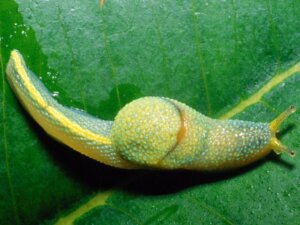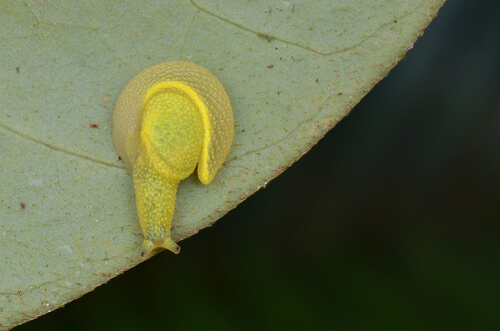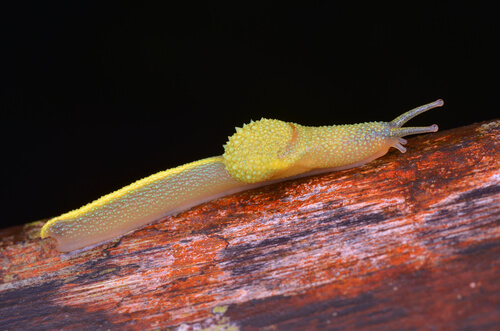Learn All About the Ninja Snail


Written and verified by the biologist Cesar Paul Gonzalez Gonzalez
Mollusks are a very diverse and attractive taxonomic group, as there are specimens of all sorts of different sizes, shapes, and colors. Although these organisms reach their greatest diversity in aquatic environments, in terrestrial ecosystems it’s also possible to find incredible species such as the ninja snail.
The scientific name of this species is Ibycus rachelae. It belongs to the Helicarionidae family, which groups several land snails capable of throwing a “love dart” at their partners. Read on to find out more about the ninja snail.
The curious discovery of the ninja snail
In 2007, different authorities from Brunei, Indonesia and Malaysia signed up for the conservation of a highly diverse area in the heart of Borneo. The site is characterized by poorly explored tropical ecosystems, so it was expected that many new species were still undiscovered.
Between 2007 and 2010 alone, 123 new species were discovered in the heart of Borneo. This means that, since the establishment of the protection zone, an average of 3 new species were discovered every month. As if that weren’t enough, many of them had unique and peculiar characteristics, as is the case of the ninja snail and its curious “love dart”.

Habitat and distribution
The ninja snail was discovered in the region of Sabah, Malaysia, on Mount Kinabalu. This means that it tends to live at over 1900 meters (6200 feet) above sea level. Although its habitat is on a mountain, the biome corresponds to a tropical rainforest. Thanks to this, there’s enough humidity for the snail to develop its life cycle.
Physical characteristics of the ninja snail
In general, although it’s known as a snail, the appearance of this species is more similar to that of a slug with a small shell on its back. It has an elongated and widened body in the middle, which is on average 4 centimeters long (under 2 inches). However, its tail is the most elongated part of its body, and can measure up to 3 times longer than its head.
The coloration of its body maintains various transparent green tones that seem to camouflage with the vegetation. However, there are also specimens with yellow colorations. In fact, the great effectiveness of its camouflage color is one of the reasons why it isn’t so easy to find invertebrates of its type.
Food
Although there isn’t much data on its biology, it’s likely that the ninja snail maintains the same herbivorous diet as its congeners. That’s to say that it feeds on the leaves that exist in its environment. It should be noted that neither snails nor slugs have jaws, but, rather, have a hard, serrated structure known as a radula that allows them to “scrape” plant matter.

Reproduction of the ninja snail
As with other snails and slugs, the ninja snail is a hermaphrodite animal. This means that it has both reproductive apparatuses in its body. However, it’s incapable of self-fertilization and requires a partner for one to act as male and the other as female.
To decide who will take the role of male and female, there’s usually a battle that consists of throwing “love darts” at each other and seeing who is the first to receive it. The “love darts ” are small “harpoons” made of chitin-containing hormones, which increase the fertility of the target snail. Because of this, the specimen receiving this dart will have to play the role of the female.
Once the roles have been decided, the snail acting as the male injects his partner with a bag containing all his sperm (spermatophore). In this way, copulation is completed and the specimen acting as the female is ready for oviposition.
As you may have guessed, due to the lack of information on the natural history of the ninja snail, it isn’t yet possible to fully describe all its habits. However, thanks to the Borneo Heartland Conservation Project, it’s likely that, in the future, all the secrets of this species will be revealed.
Mollusks are a very diverse and attractive taxonomic group, as there are specimens of all sorts of different sizes, shapes, and colors. Although these organisms reach their greatest diversity in aquatic environments, in terrestrial ecosystems it’s also possible to find incredible species such as the ninja snail.
The scientific name of this species is Ibycus rachelae. It belongs to the Helicarionidae family, which groups several land snails capable of throwing a “love dart” at their partners. Read on to find out more about the ninja snail.
The curious discovery of the ninja snail
In 2007, different authorities from Brunei, Indonesia and Malaysia signed up for the conservation of a highly diverse area in the heart of Borneo. The site is characterized by poorly explored tropical ecosystems, so it was expected that many new species were still undiscovered.
Between 2007 and 2010 alone, 123 new species were discovered in the heart of Borneo. This means that, since the establishment of the protection zone, an average of 3 new species were discovered every month. As if that weren’t enough, many of them had unique and peculiar characteristics, as is the case of the ninja snail and its curious “love dart”.

Habitat and distribution
The ninja snail was discovered in the region of Sabah, Malaysia, on Mount Kinabalu. This means that it tends to live at over 1900 meters (6200 feet) above sea level. Although its habitat is on a mountain, the biome corresponds to a tropical rainforest. Thanks to this, there’s enough humidity for the snail to develop its life cycle.
Physical characteristics of the ninja snail
In general, although it’s known as a snail, the appearance of this species is more similar to that of a slug with a small shell on its back. It has an elongated and widened body in the middle, which is on average 4 centimeters long (under 2 inches). However, its tail is the most elongated part of its body, and can measure up to 3 times longer than its head.
The coloration of its body maintains various transparent green tones that seem to camouflage with the vegetation. However, there are also specimens with yellow colorations. In fact, the great effectiveness of its camouflage color is one of the reasons why it isn’t so easy to find invertebrates of its type.
Food
Although there isn’t much data on its biology, it’s likely that the ninja snail maintains the same herbivorous diet as its congeners. That’s to say that it feeds on the leaves that exist in its environment. It should be noted that neither snails nor slugs have jaws, but, rather, have a hard, serrated structure known as a radula that allows them to “scrape” plant matter.

Reproduction of the ninja snail
As with other snails and slugs, the ninja snail is a hermaphrodite animal. This means that it has both reproductive apparatuses in its body. However, it’s incapable of self-fertilization and requires a partner for one to act as male and the other as female.
To decide who will take the role of male and female, there’s usually a battle that consists of throwing “love darts” at each other and seeing who is the first to receive it. The “love darts ” are small “harpoons” made of chitin-containing hormones, which increase the fertility of the target snail. Because of this, the specimen receiving this dart will have to play the role of the female.
Once the roles have been decided, the snail acting as the male injects his partner with a bag containing all his sperm (spermatophore). In this way, copulation is completed and the specimen acting as the female is ready for oviposition.
As you may have guessed, due to the lack of information on the natural history of the ninja snail, it isn’t yet possible to fully describe all its habits. However, thanks to the Borneo Heartland Conservation Project, it’s likely that, in the future, all the secrets of this species will be revealed.
All cited sources were thoroughly reviewed by our team to ensure their quality, reliability, currency, and validity. The bibliography of this article was considered reliable and of academic or scientific accuracy.
- Lodi, M., & Koene, J. M. (2016). The love-darts of land snails: integrating physiology, morphology and behaviour. Journal of Molluscan Studies, 82(1), 1-10.
- Persoon, G. A., & Osseweijer, M. (Eds.). (2008). Reflections on the Heart of Borneo (Vol. 24). Wageningen, The Netherlands: Tropenbos International.
- World Wide Fund For Nature. (2010). Borneo’s New World: Newly Discovered Species in the Heart of Borneo. Recuperado el 8 de octubre de 2022, disponible en: http://awsassets.panda.org/downloads/wwfborneosnewworldspecies.pdf
- Schilthuizen, M., & Liew, T. S. (2008). The slugs and semislugs of Sabah, Malaysian Borneo (Gastropoda, Pulmonata: Veronicellidae, Rathouisiidae, Ariophantidae, Limacidae, Philomycidae). Basteria, 72(4/6), 287-306.
This text is provided for informational purposes only and does not replace consultation with a professional. If in doubt, consult your specialist.








